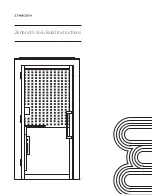
How to Operate the Strobe Light
Lock Modes – Accelerometer Input Required
4 - 8
Strobe Light
User
Manual
signal from the accelerometer to control the
flash rate using the wide band filter lock.
•
Press the
INPUT / MEMORY
button again to go
into the narrow band filter lock. The
LOCK
icon
will blink.
The Narrow and Wide Bandwidth filters can be used
to optimize its ability to lock onto the vibration signal
at any speed. The Wide bandwidth allows the strobe
to track the signal over a fairly wide range of speed
change and should be used when tracking the
fundamental frequency (in simple systems).
On machines such as a gear drives, reciprocating
engines, or any drive with multiple fundamental
frequency excitation, the strobe could encounter
difficulty tracking the designated signal, due to the
tracking filter’s normal bandwidth. If substantial levels
of multiple fundamental frequencies, or fundamentals
with harmonics occur within a selected bandwidth, the
shaft reference may appear to oscillate, or drift
substantially, when viewed with the Strobe Light.
Also, if the accelerometer cannot be positioned on the
primary point of interest, a fundamental frequency of
something other than that of the primary point of
interest may be predominant. In these cases, use the
Internal mode and flash rate adjust to stop the motion
of the primary point of interest, then use the Narrow
Bandwidth LOCK mode. The filter is far more
sensitive and will better be able to discriminate the
required signal. However, it will not be able to track
over widely varying speed changes, which will require
retuning in the Internal mode.
After the image has been locked and the Narrow or
Wide Bandwidth has been optimized for the speed
and / or background noise on the sensor signal, the
phase knob can be used to adjust the phase of the
















































